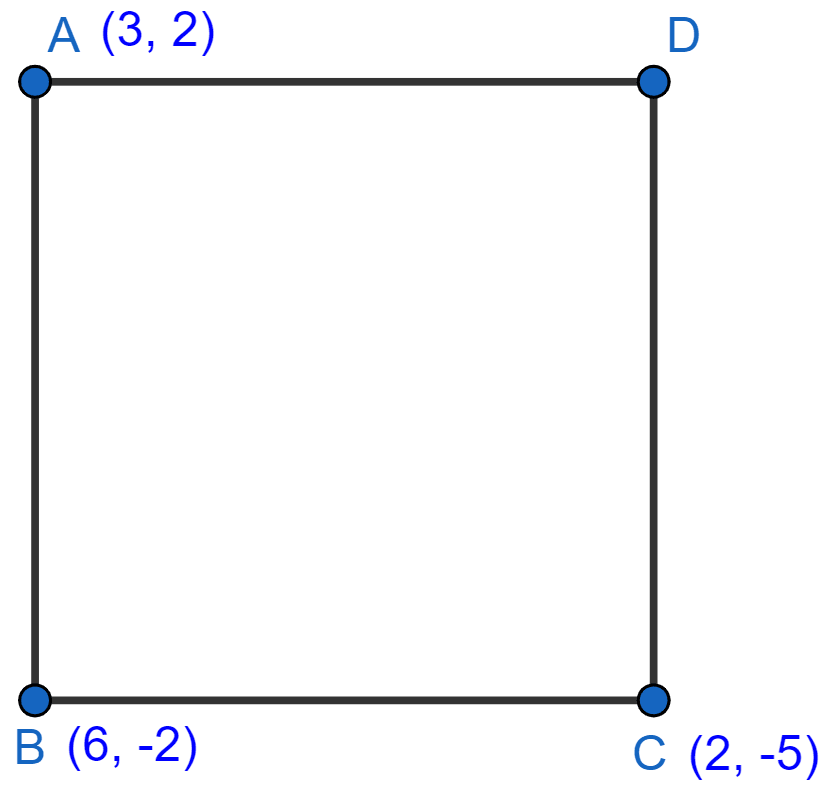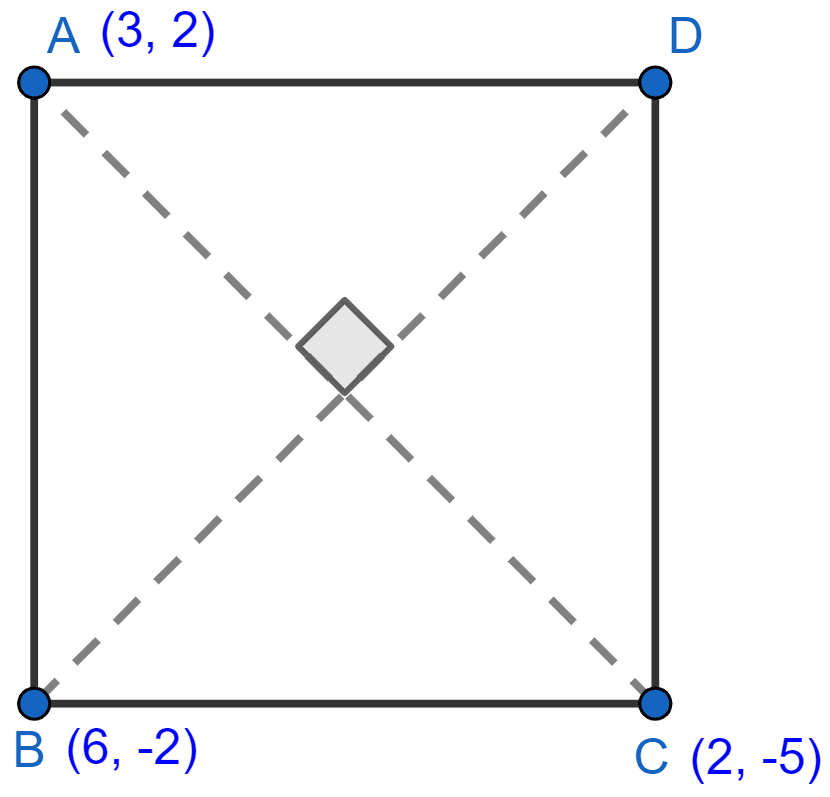Mathematics
Show that A (3, 2), B (6, -2) and C (2, -5) can be the vertices of a square.
(i) Find the co-ordinates of its fourth vertex D, if ABCD is a square.
(ii) Without using the co-ordinates of vertex D, find the equation of side AD of the square and also the equation of diagonal BD.
Straight Line Eq
14 Likes
Answer
Given, A (3, 2), B (6, -2) and C (2, -5)

By distance formula,
Distance between two points =
Thus, AC = BC
By formula,
Slope =
Slope of AB =
Slope of BC =
Slope of AB x Slope of BC = = -1
Hence, AB ⊥ BC
Therefore, A, B, C can be the vertices of a square.
(i) Slope of CD = Slope of AB = (As they are parallel)
So, the equation of CD is
⇒ y – y1 = m(x – x1)
⇒ y - (-5) = (x – 2)
⇒ 3(y + 5) = -4(x - 2)
⇒ 3y + 15 = -4x + 8
⇒ 4x + 3y + 7 = 0 ………(1)
Slope of AD = Slope of BC = (As these lines are parallel)
So, the equation of the line AD is
⇒ y – y1 = m(x – x1)
⇒ y - 2 = (x - 3)
⇒ 4(y – 2) = 3(x – 3)
⇒ 4y - 8 = 3x - 9
⇒ 3x - 4y = -8 + 9
⇒ 3x - 4y = 1 ……… (2)
Now, D is the point of intersection of CD and AD.
Solving (1) and (2),
Multiplying equation (1) by 4 and (2) by 3 and adding them we get,
⇒ 16x + 12y + 28 + 9x – 12y = 0 + 3
⇒ 25x = 3 - 28
⇒ 25x = -25
⇒ x = -1
Putting value of x in (1), we get
⇒ 4(-1) + 3y + 7 = 0
⇒ 3y - 4 + 7 = 0
⇒ 3y + 3 = 0
⇒ 3y = -3
⇒ y = -1
Hence, the co-ordinates of point D are (-1, -1).
(ii) From the equation (2)
The equation of the line AD is,
⇒ 3x – 4y = 1
⇒ 4y = 3x - 1.
Slope of AC =

Since, diagonals of a square are perpendicular to each other. So, product of their slopes = -1.
∴ Slope of AC × Slope of BD = -1
⇒ Slope of BD = -1
⇒ Slope of BD = -.
The equation of the diagonal BD is
⇒ y – y1 = m(x – x1)
⇒ y - (-2) = (x - 6)
⇒ 7(y + 2) = –1(x – 6)
⇒ 7y + 14 = -x + 6
⇒ x + 7y + 14 - 6 = 0
⇒ x + 7y + 8 = 0.
Hence, equation of line BD is x + 7y + 8 = 0 and AD = 4y = 3x - 1.
Answered By
7 Likes
Related Questions
A line 5x + 3y + 15 = 0 meets y-axis at point P. Find the co-ordinates of point P. Find the equation of a line through P and perpendicular to x - 3y + 4 = 0.
A straight line passes through the points P (-1, 4) and Q (5, -2). It intersects the co-ordinate axes at points A and B. M is the mid-point of the segment AB. Find:
(i) The equation of the line.
(ii) The co-ordinates of A and B.
(iii) The co-ordinates of M.

A line through origin meets the line x = 3y + 2 at right angles at point X. Find the co-ordinates of X.
A straight line passes through the point (3, 2) and the portion of this line, intercepted between the positive axes, is bisected at this point. Find the equation of the line.